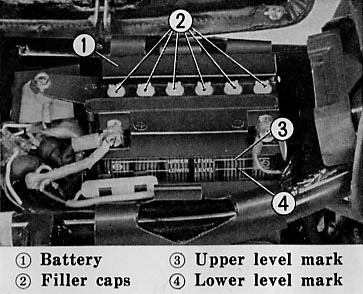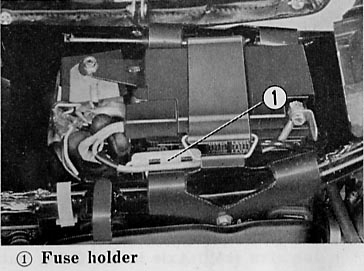|
|
|
Battery Electrolyte Replenishment:
The battery is mounted under the seat, and is accessible by releasing the seat lock and raising the right side.
Raise the battery slightly to check the battery electrolyte.
Battery electrolyte level should be checked once a month. The electrolyte level must be maintained between the upper (3) and lower (4) marks on the side of the battery.

If the electrolyte level is found to be low, remove the battery filler caps and carefully add distilled water until the electrolyte level in each cell is between the upper and lower marks. Use a small syringe or plastic funnel to add water. Only distilled water should be added, to avoid contaminating the electrolyte
Battery Removal and Installation:
Battery removal may be necessary when battery electrolyte specific gravity reading is below 1.200, indicating the need of battery recharging, or when the battery is removed for storage.
NOTE: When installing the battery, be careful not to bend or twist the vent tube.
Battery Charging:
During the use of the motorcycle, should battery electrolyte specific gravity reading (measured with a hydrometer) drop below 1.200 @ 68°F (20°C), the battery should be charged at a rate not to exceed 1.2 amps until the specific gravity reading is between 1.260 and 1.280 @ 68°F (20°C). Frequent discharging or partial discharged battery condition is sometimes the result of improper starting procedure, poor engine condition and/or electrical system problems. To locate and correct the cause of this condition, we suggest you contact your HONDA dealer.
When storing the motorcycle or if it is not being used for an extended period, the battery negative (-) cable should be disconnected or the battery removed and stored in a cool place. The battery should be charged at least once a month during the storage period to preserve the battery life.

Fuse:
The fuse holder (1) is located in the battery compartment. The recommended fuse for the CB450 is 15 A. When frequent failure of the fuse occurs, it usually indicates a short circuit or on overload in the electrical system. In this case the electrical system should be checked visually for shorts or other possible malfunctions. If the problem cannot be located visually, the motorcycle should be examined by an authorized HONDA dealer.